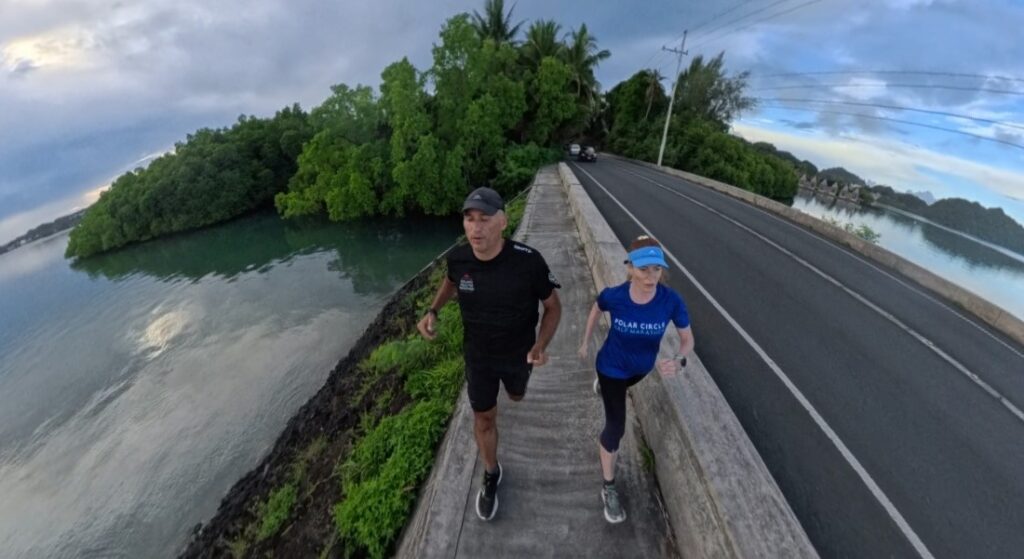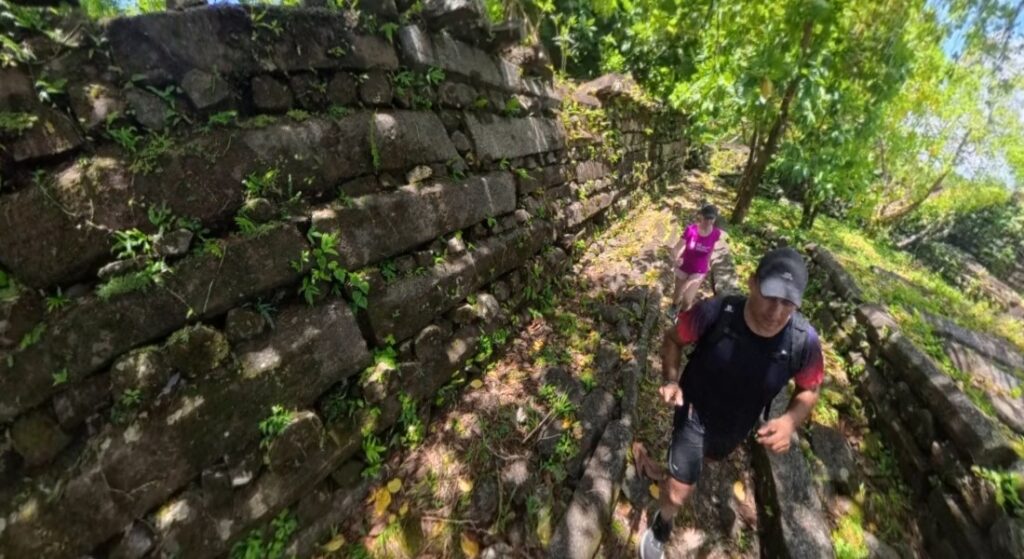Betio, Kiribati. 10 de septiembre de 2025.
En septiembre de 2025 corrimos en un lugar donde armas y búnkeres japoneses de la Segunda Guerra Mundial estaban escondidos entre los signos de una vida cotidiana muy caótica... con montones de basura, niños desnudos, perros, pollos y cerdos, e incluso tuvimos tiempo de correr en una autopista construida literalmente sobre el océano: una carretera con agua turquesa y naufragios a ambos lados.
¡Esto era Kiribati!
Una nación insular muy peculiar, esparcida a lo largo del ecuador en el Océano Pacífico central. Uno de los países más remotos y únicos de la Tierra, que nos ofreció una experiencia inolvidable.
TLDR; “demasiado largo, no lo leí”
- ¡Solo quiero correr! Llévame a CORRER.
- Tengo 1 minuto. Llévame a INFORMACIÓN ÚTIL.
- Correr es mi excusa para viajar. Llévame a VIAJE.
- Correr es mi excusa para comer. Llévame a CARBOLOADING.
- Quiero saber qué leer en el avión. Llévame a UN LIBRO.
Ya sea que esté explorando nuevas culturas, buscando rastros de la Segunda Guerra Mundial o simplemente corriendo por el placer de hacerlo, Kiribati es un destino raro y gratificante.
Así que toma tu mochila de hidratación y prepárate para marcar otra carrera en tu lista de deseos en el paraíso. 🏃♂️🌴
🌴 Por qué Kiribati debería estar en la lista de deseos de todo corredor
Dejemos una cosa clara: Kiribati no es el típico destino para correr.
No hay megamaratones, ni instalaciones deportivas llamativas, ni señales de senderos dignas de Instagram. Lo que tú hacer Lo que se consigue es algo mucho más auténtico: verdadera soledad, brisas marinas, niños curiosos animándote desde porches con techo de palma y la sensación de que realmente estás corriendo en el fin del mundo.
¡Y la oportunidad de correr pasando por auténticas reliquias de la Segunda Guerra Mundial y en la calzada de Tarawa Sur, que une varios islotes, son ambas experiencias únicas!
🌍El viaje 📷
📚 Una breve historia de Kiribati 🇰🇮📖
La historia de Kiribati es tan fascinante como su geografía. Antiguamente parte de la colonia británica conocida como las Islas Gilbert y Ellice, Kiribati obtuvo su independencia en 1979. Es uno de los pocos países que abarca los cuatro hemisferios gracias a su ubicación a ambos lados de la Línea Internacional de Cambio de Fecha. Sí, tú... literalmente ¡Corre hacia el mañana aquí! 🕰️🌍
Los habitantes de Kiribati, conocidos como I-Kiribati, tienen fuertes raíces culturales, donde la danza tradicional, la narración de cuentos y la construcción de canoas desempeñan un papel fundamental en la vida cotidiana. Se habla inglés, pero la mayoría de los habitantes locales hablan el idioma gilbertés (Te taetae ni Kiribati). Y si bien el país enfrenta amenazas reales por el aumento del nivel del mar 🌊 debido al cambio climático, su resiliencia y su vibrante comunidad lo convierten en uno de los lugares más inspiradores que jamás visitará.
Ah, y un dato curioso: el nombre "Kiribati" es simplemente la ortografía local de "Gilberts", llamada así por el explorador británico Thomas Gilbert. Como el alfabeto I-Kiribati carece de algunas consonantes inglesas, "Gilberts" se convierte en "Kiribati". 🇪🇸➡️🇰🇮
⚔️ Historia en marcha: La batalla de Tarawa
Correr en Kiribati no es solo una experiencia paisajística. Es un recorrido a través de la historia. En el extremo occidental de la isla de Betio, en Tarawa Sur, se encuentran los conmovedores restos de una de las batallas más feroces de la Segunda Guerra Mundial: la Batalla de Tarawa, librada entre los Marines estadounidenses y las fuerzas japonesas en noviembre de 1943. Fue la primera gran ofensiva estadounidense en el Pacífico central. Y tuvo un coste enorme.
En tan solo 76 brutales horas, más de 6.000 soldados perdieron la vida. La isla estaba fuertemente fortificada por los japoneses. Cuando las fuerzas estadounidenses desembarcaron, se enfrentaron a una feroz resistencia, arrecifes poco profundos que dejaron varadas las embarcaciones de desembarco y fuego devastador desde búnkeres atrincherados. El resultado fue una cabeza de playa caótica y sangrienta que cambió para siempre la forma en que se libraba la guerra anfibia.
Hoy, los restos de la batalla permanecen dispersos por Betio. Se puede correr junto a tanques oxidados semienterrados en la arena, búnkeres aún en pie entre palmeras y monumentos al aire libre que rinden homenaje a ambos bandos.
🏃♂️💭 Para los corredores, trotar por terrenos que antaño fueron escenario de tanta violencia resulta profundamente conmovedor. Es una oportunidad para honrar el pasado con cada paso y apreciar la paz en uno de los rincones más remotos del mundo.
¡A Tarawa! ¡Corriendo y explorando las reliquias de Betio!
Volando hacia la historia
Nuestro vuelo de Nadi a Tarawa fue en un Boeing 737 ✈️. Lo leí en el folleto y pensé en los accidentes relacionados con este modelo. Me puse nerviosa por un momento 😨. A nuestro alrededor, los habitantes de Kiribati se reían a carcajadas; unos hombres corpulentos con pasaportes en la mano. El ambiente isleño ya se sentía a bordo.
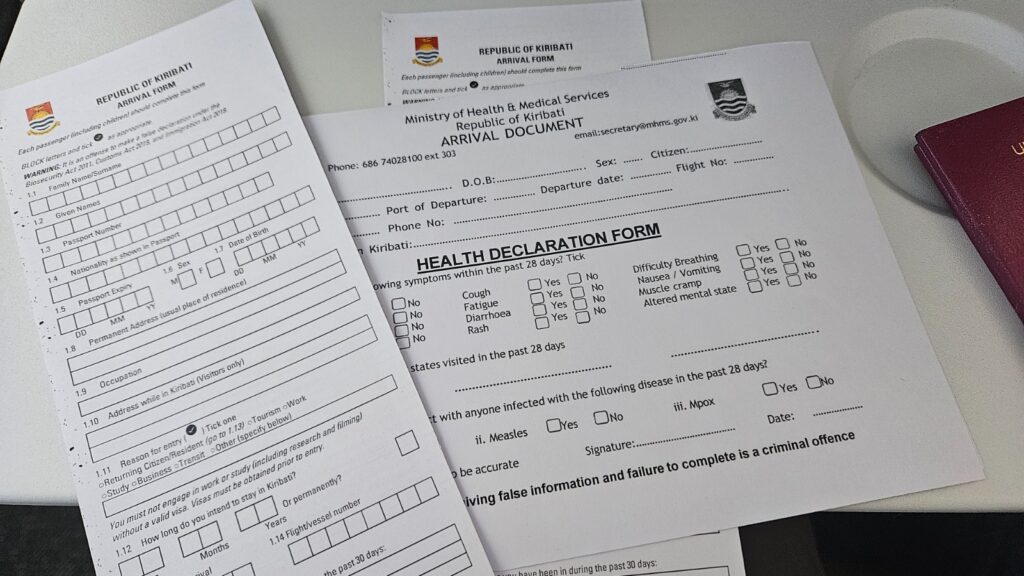
Estaba emocionado. Tarawa no era una parada más. Fue el escenario de la Batalla de Tarawa, una de las batallas más sangrientas de la Segunda Guerra Mundial en el Pacífico. Había leído sobre ella, visto documentales e incluso el video de Ramilla. Sabía que este viaje sería diferente.
Al descender, apreté la cara contra la ventana. Abajo se extendía una delgada franja de arena blanca, bordeada de cocoteros y salpicada de pequeñas casas. El agua turquesa lo rodeaba todo. El atolón parecía frágil y hermoso, un paraíso con cicatrices de historia por descubrir.
Llegada a Tarawa
La aduana era sorprendentemente formal, con agentes uniformados en cinco mostradores. Pasamos rápidamente. Afuera, el calor nos azotaba. El aire era pesado y el sol brutal ☀️.
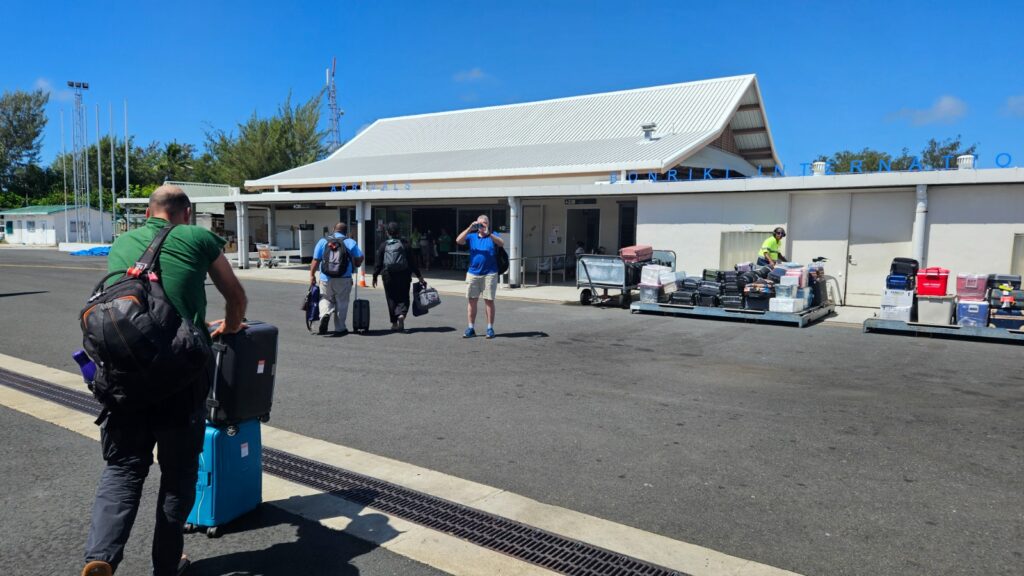
Conduciendo hacia el sur, la laguna se reveló. Extremos de arena blanca cegadora se extendían hasta el horizonte, rodeados de aguas azules poco profundas. Los manglares asomaban sus raíces en la marea baja. Me recordó a Tuvalu, solo que más grande. Pero la basura me impactó. Neumáticos, botellas, plástico por todas partes. Un paraíso manchado.
La gente dormía a la sombra. Los perros cruzaban la calle. El tráfico se arrastraba por la única vía principal. Pasamos por el Parlamento, un vertedero gigante en medio de casas y almacenes chinos con enormes carteles. Entonces apareció Bairiki con su plaza, banderas e incluso un cajero automático.
A lo lejos vi una enorme noria abandonada 🎡. Oxidada, surrealista y hermosa a su vez. Entre Bairiki y Betio se extendía una larga calzada. A cada lado, solo océano. Supe al instante que quería correr hasta allí.
Primer paseo por Betio
Al caer la tarde, salimos a explorar Betio. El sol se puso, se acumularon nubes y llevamos impermeables. ¡Qué buena jugada!
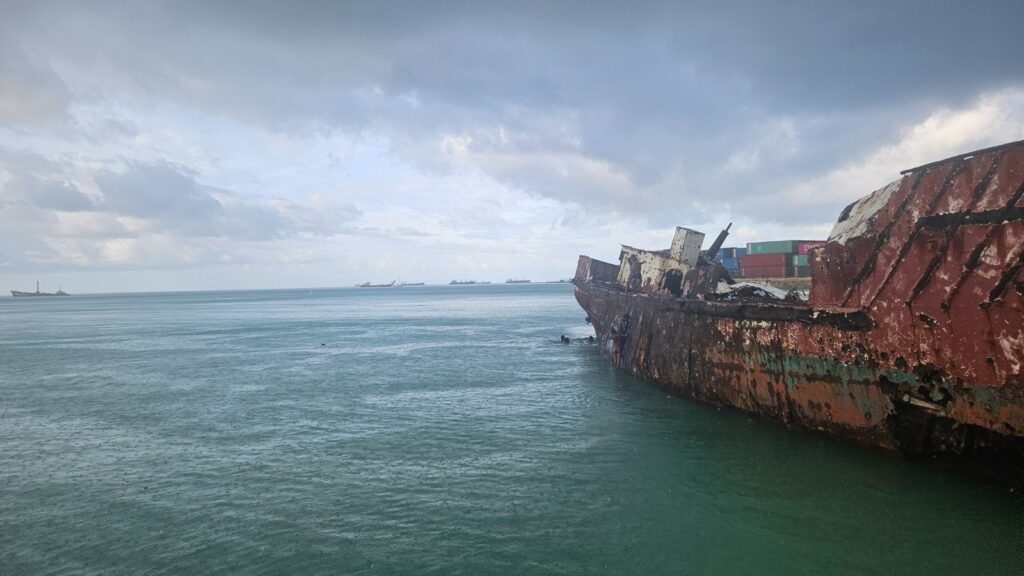
Llegamos a la costa, donde un enorme naufragio oxidado se asomaba justo en la calle 🚢. Los niños lo escalaban y saltaban al agua, riendo y gritándonos "¡Dinero, dinero!". La escena era viva y pura. Empezó a llover. Primero suave, luego con fuerza. Y era mágico.
Allí de pie, empapado, viendo a los niños saltar de un naufragio de la Segunda Guerra Mundial a la laguna, me sentí completamente presente. El Pacífico rugía, los niños reían, y la lluvia me daba igual. Fue uno de esos momentos de viaje que se quedan grabados en la memoria.
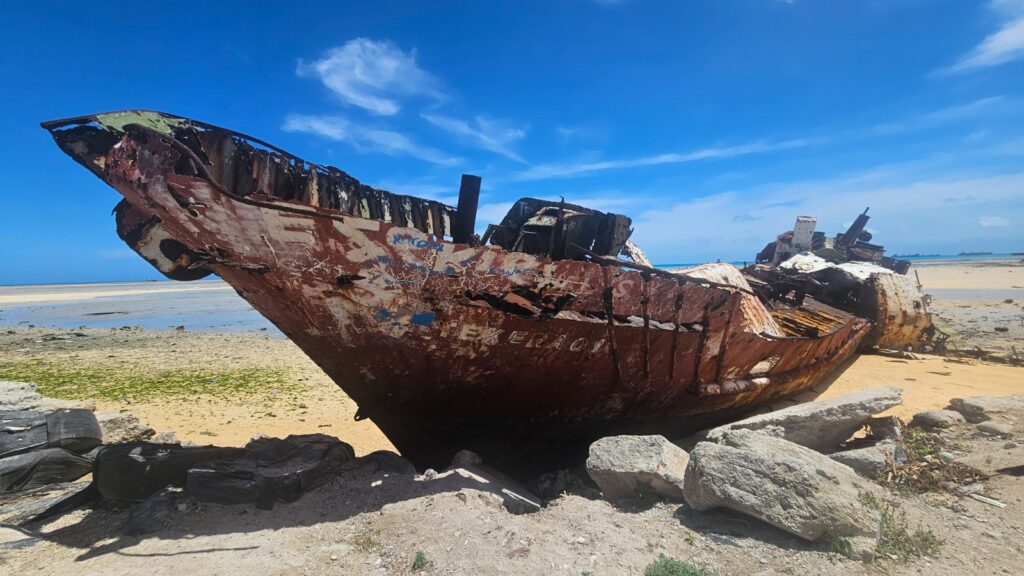
A pocos metros, la realidad nos golpeó. Un hombre tiró un cubo de basura justo delante de nosotros. El olor era horrible. Junto a él había un viejo cañón de la Segunda Guerra Mundial, oxidado y abandonado, con perros callejeros dando vueltas. Eso era Betio en pocas palabras. Belleza y decadencia juntas.
Reliquias de la batalla de Tarawa
Al día siguiente fuimos a buscar reliquias 🪖. Llevaba manga larga y protector solar, y después de tres horas al sol no me quemé.
Nos desviamos del camino hacia patios donde vivían familias. Un hombre desdentado en una hamaca sonreía mientras los cerdos escarbaban entre montones de basura. Un hombre escuchaba a todo volumen "My Heart Will Go On" de Céline Dion desde una cabaña mientras los niños perseguían gallinas. Era caótico y fascinante.
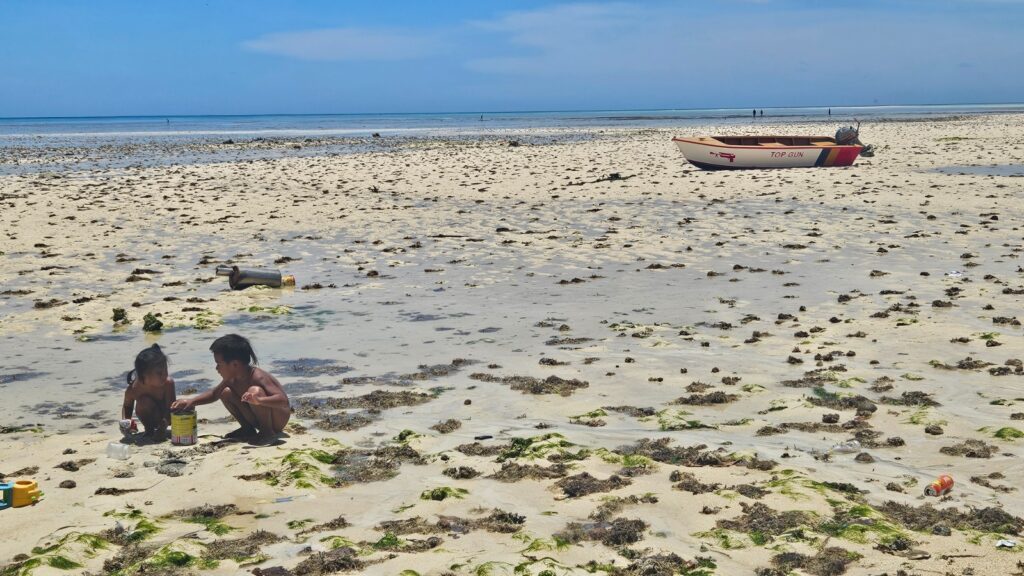
En medio del caos se alzaban emplazamientos de armas japoneses. Oxidados, olvidados, rodeados de basura. En uno de ellos, un hombre casi lo usó como baño hasta que nos vio. La historia aquí no estaba tras un cristal. Era parte de la vida cotidiana, ignorada, reutilizada o simplemente estorbando.
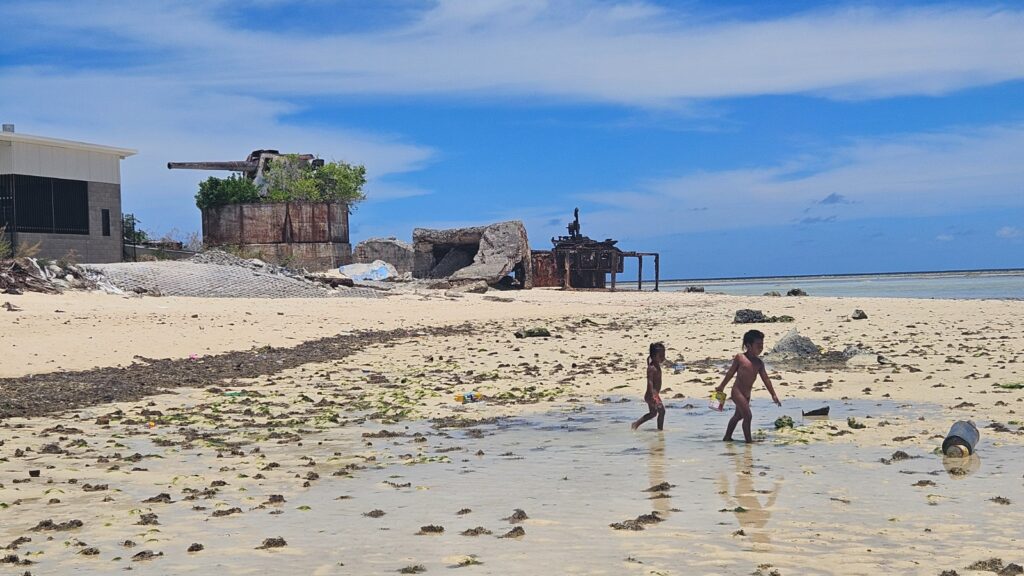
Encontramos un cementerio lleno de escombros, con tumbas rotas, salvo unas pocas con flores frescas. Destacaba la tumba de «Antonio», fallecido hacía exactamente un año. El contraste entre la vida, la muerte y la historia, todo mezclado, era surrealista.
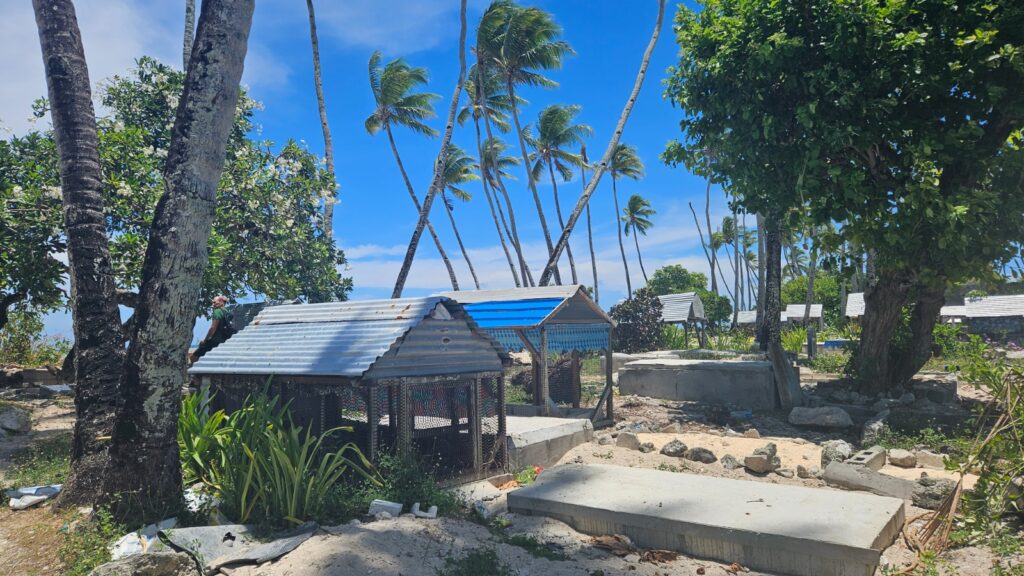
El tanque Sherman y Red Beach
Continuamos por Red Beach, lugar de desembarco de los marines estadounidenses en 1943. Entre niños que gritaban Bai bai bai y perros callejeros bajo las palmeras, encontramos tesoros.
Primero, otra pistola japonesa.
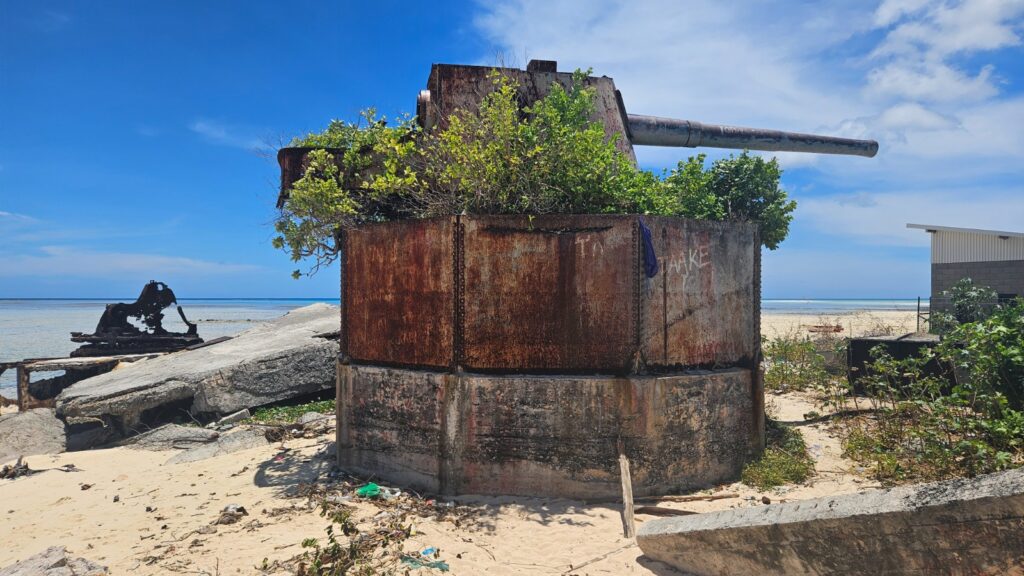
Luego, tras cruzar la marea baja, el premio: un tanque Sherman. Oxidado pero intacto. Roger se subió mientras yo tomaba fotos. Tocar semejante historia en el Pacífico me pareció surrealista.
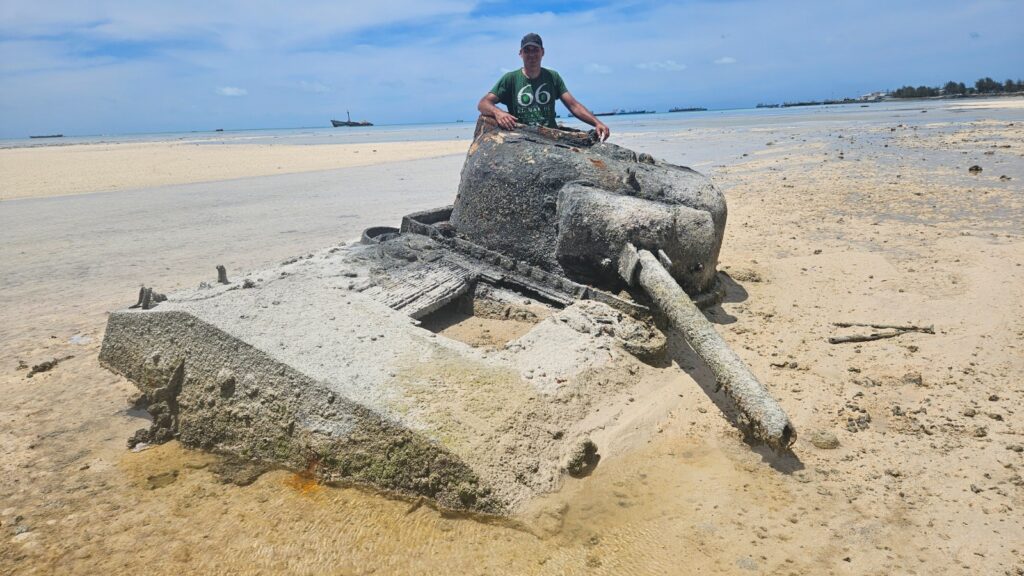
También vimos la Iglesia Católica de Kaotitaeaka, de un azul brillante y sencilla.
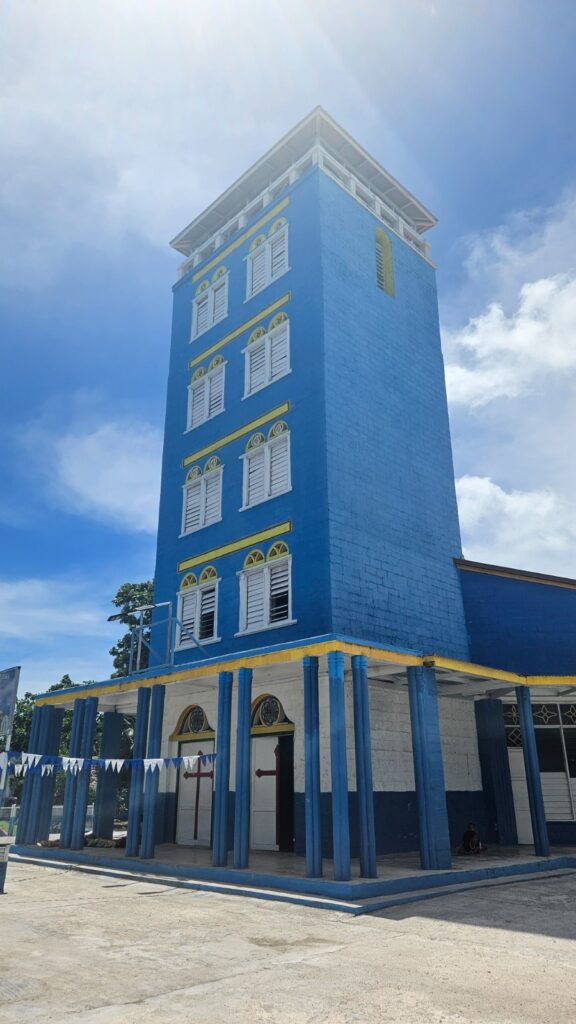
Y una Maneaba, el gran salón donde se reunían los lugareños. La vida transcurría alrededor de estas reliquias, mezclando la rutina diaria con los recuerdos de la guerra.

Betio hoy
Betio era caótico, sucio y lleno de vida. Naufragios, armas, búnkeres y tanques se alzaban entre escombros, mercados y niños jugando. La historia aquí no estaba pulida ni curada. Era cruda, vivida e inolvidable.
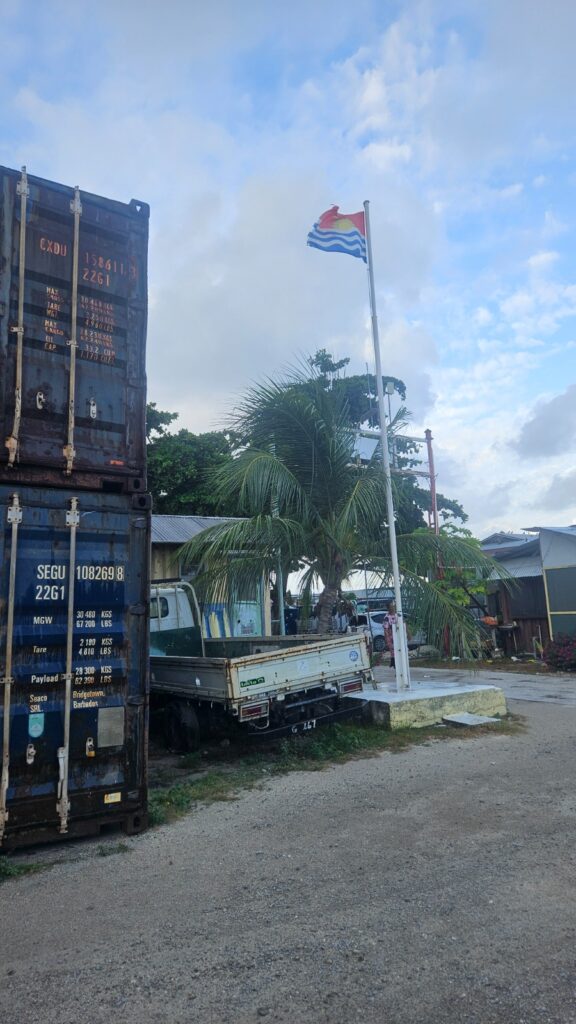
Cruzar la autopista Bairiki y explorar reliquias de la Segunda Guerra Mundial hicieron de Tarawa uno de los lugares más singulares que he visitado.
Cruzando hacia Tarawa Norte 🚤
También nos aventuramos a Tarawa Norte. Con la ayuda de un guía local, alquilamos un barco y nos dirigimos allí desde el puerto. El puerto fue interesante porque vimos lo que pensé que era un buque con bandera de Kiribati. Resultó ser el RKS Teanoai II (301), un barco patrullero de la clase Guardian al servicio de la Policía Marítima de Kiribati.
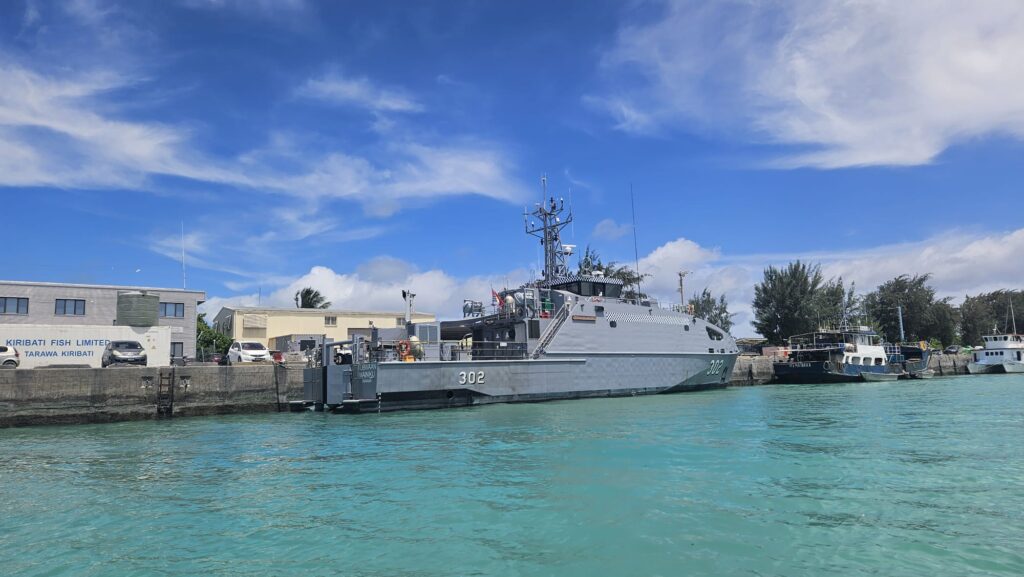
Australia lo había cedido a la República de Kiribati como parte del Programa de Seguridad Marítima del Pacífico. Mediante este programa, Australia dona lanchas patrulleras a las naciones insulares del Pacífico para mejorar la seguridad marítima regional.
Luego pasamos por enormes barcos pesqueros chinos. Tenían caracteres chinos por todas partes. Incluso vimos un par de Port Vila. Es agradable ver que ahora conocemos las capitales y ciudades del Pacífico Sur 🙂 ¡Hasta Roger las conocía por entonces!

Tarawa Norte parecía una aventura incluso antes de llegar. Estábamos entusiasmados por explorar más, alejarnos de la bulliciosa zona de Betio y ver cómo era la vida fuera de la capital. Y todo comenzó con este inusual paseo en barco por la laguna.
La Laguna 🌊
El barco era de pesca, pequeño y sencillo. Solo tenía un motor y dos pescadores: el piloto y un joven cubierto con lo que parecía un hiqab 🙂 que nos ayudaba con la logística, como buscar corales peligrosos y aguas poco profundas. Nos sentamos en una mesa de madera, que era el único sitio donde sentarse.
Fue increíblemente incómodo. El viaje duró más de una hora. Me sufría tanto la espalda con los continuos saltos que, de regreso, tuve que tumbarme como un feto sobre la mesa, con la cabeza sobre las piernas de Roger.
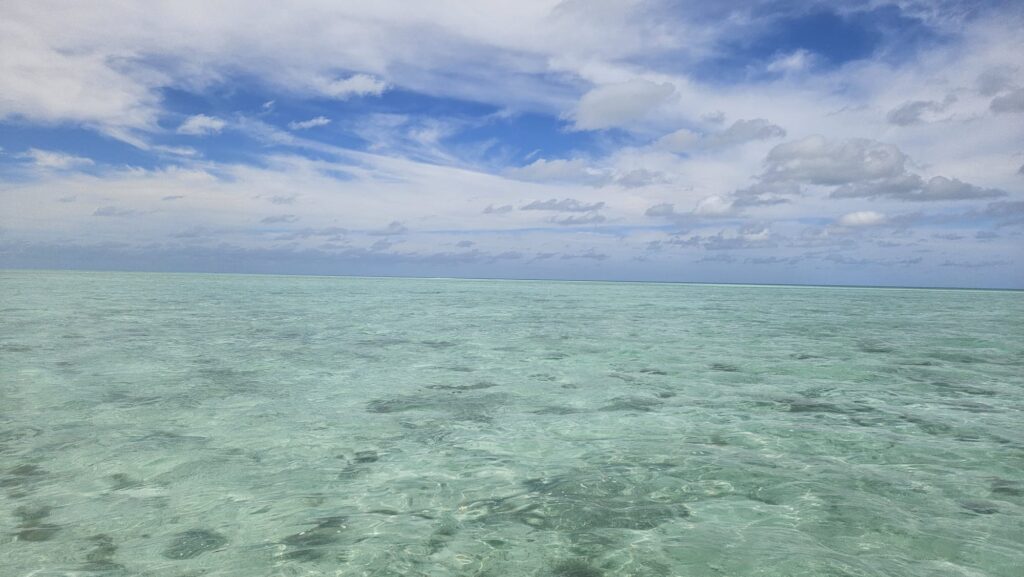
Sin embargo, el paisaje era impresionante. El agua era de un turquesa cristalino y, en algunos puntos, parecía esmeralda. El cielo azul y la arena blanca de los bancos de arena enmarcaban la laguna.

La laguna de Tarawa se encuentra en el corazón del atolón capital de Kiribati. Es un lugar donde la belleza natural y la vida humana se unen en un contraste sorprendente. Las aguas turquesas están enmarcadas por delgadas franjas de tierra salpicadas de pueblos, cocoteros y reliquias de la Segunda Guerra Mundial.
Barcos pesqueros y canoas con balancines surcan la tranquila laguna como lo han hecho durante generaciones. Es el centro más vibrante del país, hogar de más de la mitad de la población de Kiribati. Ofrece una visión única de la vida en los atolones. Sin embargo, bajo la superficie se encuentra un ecosistema frágil, rico en vida marina, pero cada vez más amenazado por la contaminación, la sobrepesca y la subida del nivel del mar.
Colegio Taborio y el Inmaculado Corazón 🙏
Nuestra primera parada fue en Taborio, cerca de Noto, donde visitamos un internado llamado Colegio del Inmaculado Corazón. Estaba bien cuidado, muy limpio, con flores y varios jardines. Los estudiantes, en su mayoría adolescentes, vestían polos color azafrán. Nos miraron con indiferencia y nos insultaron con una palabra que, según explicó nuestro guía, significa "persona blanca" en su idioma.
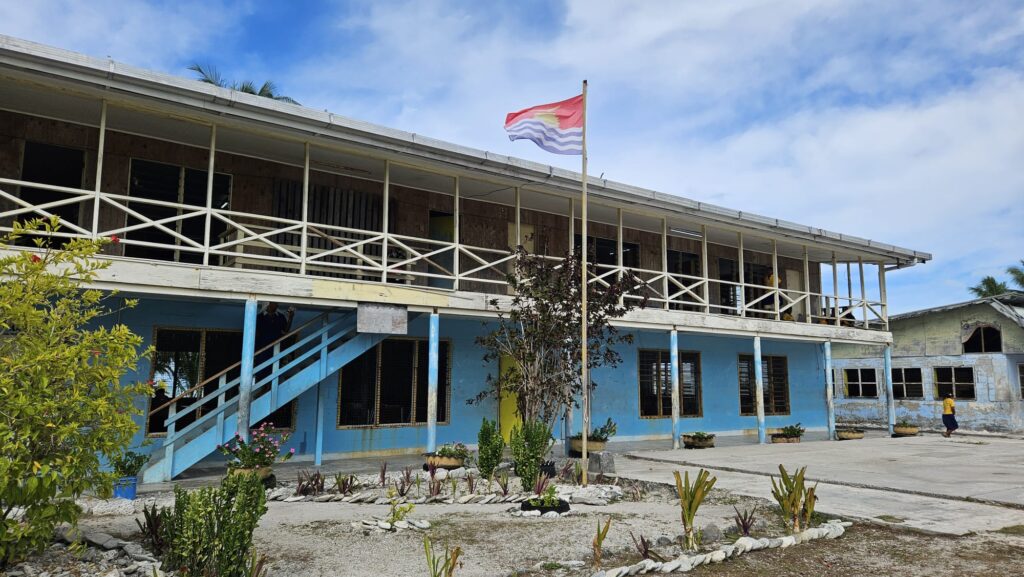
Nuestro guía era profesor. Explicó que se cansó del trabajo porque no solo tenía que dar clases, sino también cuidar a los niños después del horario de trabajo. Tenía que servirles la comida e incluso lavarles la ropa. Así que renunció 🙂 Nos explicó que en Kiribati hay una gran devoción a la Virgen María. Vimos muchas estatuas en la escuela, todas muy bien conservadas.
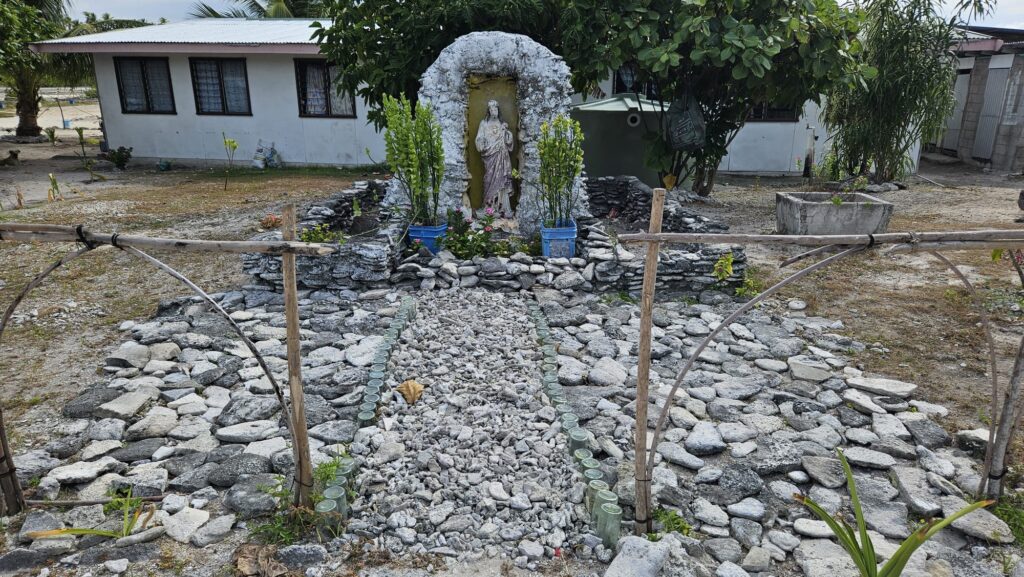
La escuela era bonita, con perros callejeros por todas partes. También había una Maneaba, un salón de actos, construido sobre el agua. Y algo inusual: el campo de fútbol también parecía estar en el agua. Era una extensión de arena blanca con algo de agua, similar a las playas con marea baja. En lugar de jugadores, había miles de cangrejos 🙂
Buariki y la vida rural 🐖
Después de Noto, continuamos hacia el norte hasta llegar al punto más alejado de Tarawa Norte, en Buariki. El pueblo era muy diferente de Betio. Era rural, con chozas tradicionales con techo de paja. Los niños sonreían a nuestro alrededor mientras cerdos, gallinas y perros se movían libremente.
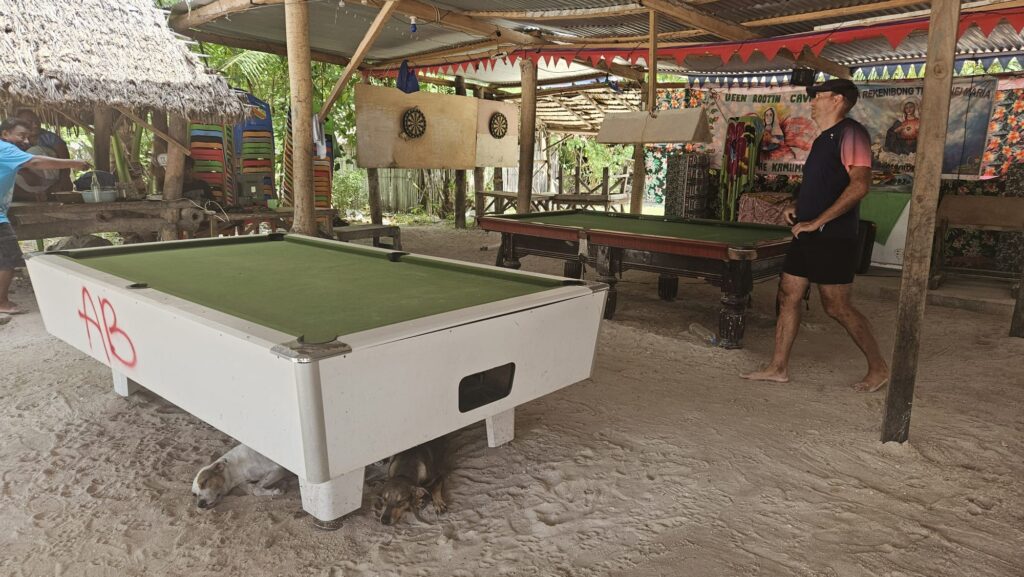
Pasamos por un bar de cava donde la gente veía un partido del FC Barcelona contra el Real Madrid. Fue divertidísimo. A nuestro guía le pareció muy curioso, ya que le habíamos dicho que éramos de Barcelona. Dos perros callejeros dormían bajo una de las dos mesas de billar. Lienzos de Jesús y la Virgen María servían de paredes.
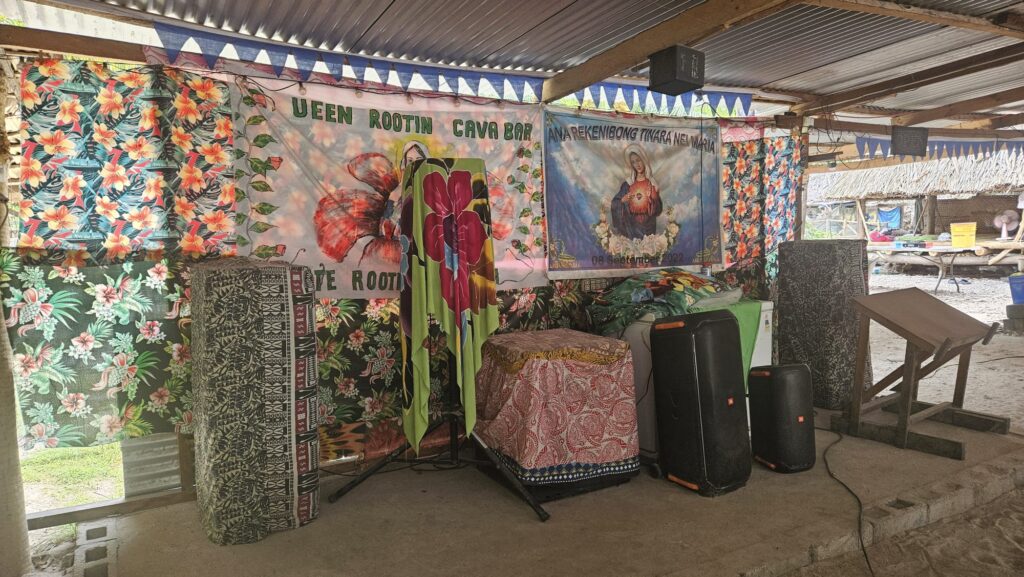
Era exótico, peculiar y auténtico. Vimos otra maneaba, esta con techo de paja, donde dormían lugareños. Luego continuamos hasta la casa de un amigo de nuestro guía. Un hombre que parecía de unos 17 años, pero ya tenía hijos, nos abrió cocos. Les hizo un agujero y nos dio agua para beber. Empezaba a disfrutar mucho del agua de coco.

Sus dos hijitas, semidesnudas y monísimas, jugaban conmigo. Me hacían levantar el pulgar y hacer cosas graciosas mientras reían y decían "bai bai".
Vida, árboles e historias 🌴
A la sombra de su mini Maneaba, nuestro guía explicó que Tuvalu solía ser parte de Kiribati. Se independizaron porque desconfiaban de la justicia de los kiribatienses. Luego continuó explicando cosas interesantes.
Nos mostró los tres árboles que hacen posible la supervivencia en un hogar tradicional de Kiribati: la palma cocotera, el árbol del pan y el pandano. La palma cocotera, llamada te ni, proporciona alimento, bebida, materiales de construcción y tejidos. El árbol del pan, llamado te mai, es un alimento básico, asado, hervido o utilizado en platos tradicionales. El pandano, llamado te kaina, es igualmente importante. Su fruto se consume fresco o en conserva, y sus largas hojas se tejen para fabricar esteras, techos de paja y artículos de uso diario.
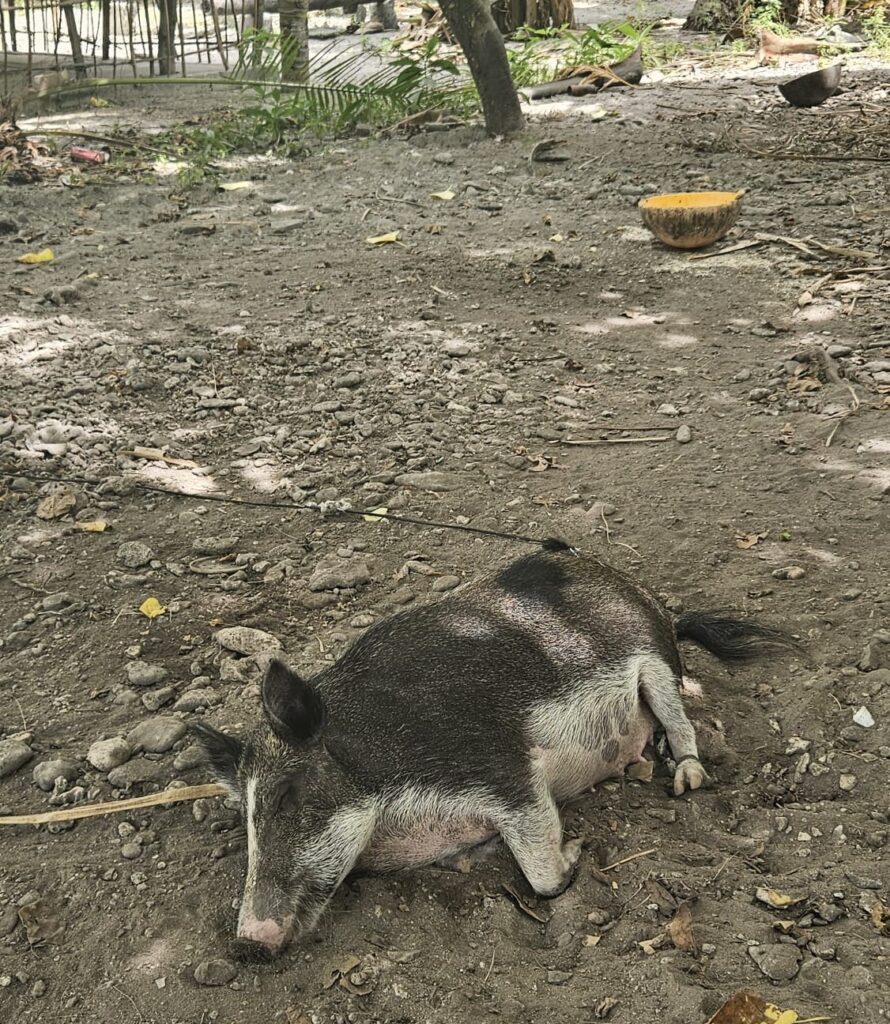
También dijo que en todas las fiestas tradicionales se debe sacrificar un cerdo. El cerdo siempre se come. Mientras señalaba a los lechones que dormían bajo las palmeras, explicó que una familia con muchos cerdos es una familia rica.
Finalmente llegamos al punto más septentrional de la isla. Era una playa de arena blanca con palmeras y algo de basura. La típica escena de Tarawa.
Snorkel en la Laguna 🐠
Nuestra última parada fue hacer snorkel en la laguna. Nadamos de nuevo en aguas turquesas, disfrutando de peces y corales. En algunos puntos, los corales estaban tan cerca de la superficie que incluso choqué con uno.
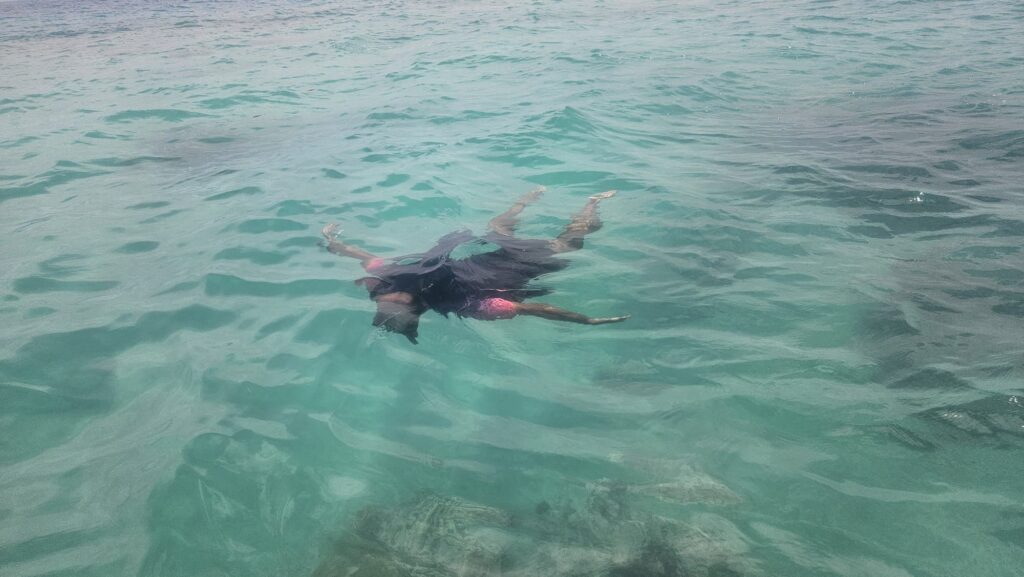
El momento divertido llegó cuando tuve que volver a subir al bote. No había escaleras, claro, ya que era un bote pesquero rudimentario. Roger me sacó del agua mientras uno de los pescadores me sacaba del interior. Conseguí tumbarme boca abajo sobre la terraza del bote y luego me impulsé hasta caer de forma muy indigna, con la cabeza en el suelo. Fue patético, pero logré subir de nuevo. No se tomaron fotos 🙂 El único recuerdo de esto será el de Roger partiéndose de risa.
El snorkel marcó el final de nuestra aventura en Tarawa Norte. Había sido un día lleno de correr por las islas, reír con los lugareños, aprender tradiciones y nadar en aguas cristalinas. De eso se trata viajar en Kiribati.
🏃♀️ La carrera 🏃♂️
Comenzando la carrera y enfrentándose a los perros
Empezamos a correr a las 7 de la mañana y ni un minuto tarde 🌅. El sol ya estaba fuerte y pronto nos castigaría. Sabía que deberíamos haber empezado a las 6:30. Incluso esa media hora marca una gran diferencia en Kiribati. El calor es intenso y la humedad lo empeora.
A veces cae un chaparrón repentino y te empapa en segundos. Al menos eso alivia un poco.
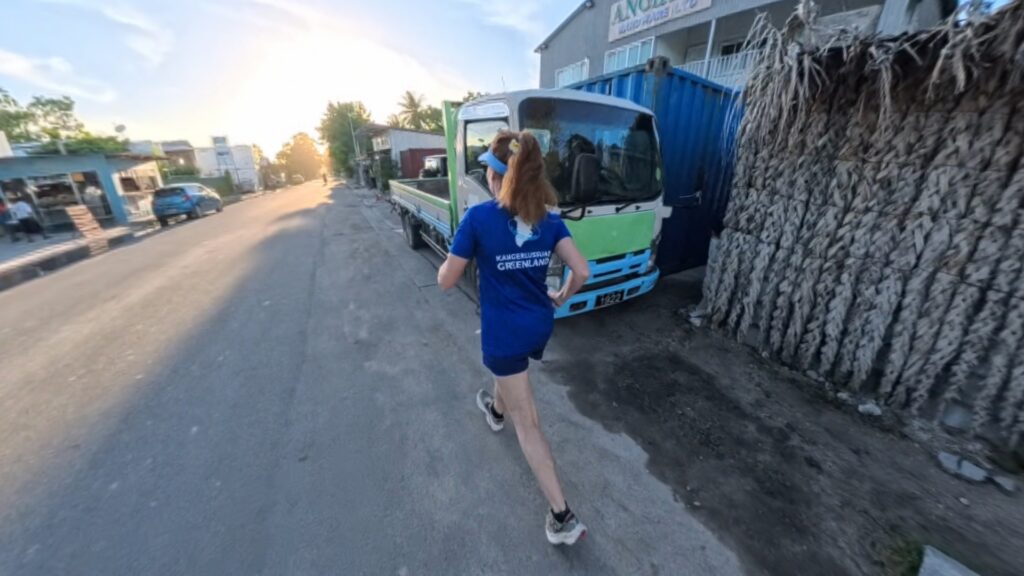
Lo que más me preocupaba eran los perros 🐕. En Tuvalu, y sobre todo en Tonga, tuvimos muy malas experiencias. Una vez, Roger tuvo que enfrentarse a ocho perros que intentaron atacarnos. Ayer vi perros callejeros aquí en Betio. Se me encogió el estómago. Salimos del albergue y corrimos hacia Bairiki.
Las calles seguían medio dormidas. Algunos vecinos barrían. Otros se despertaban poco a poco. Por suerte, los perros callejeros no atacaron. Ni siquiera ladraron. Probablemente seguían durmiendo.
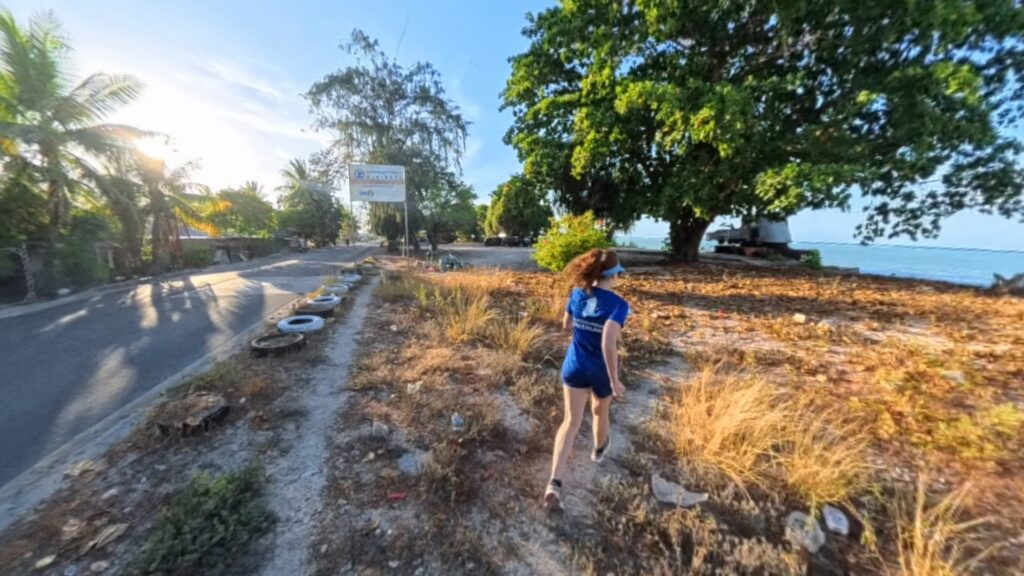
Mi corazón latía con fuerza hasta que regresamos al hotel más de una hora después. Correr allí no era solo un deporte. También se trataba de estar alerta y ser cuidadoso. Eso hacía que cada kilómetro pareciera aún más aventurero.
Reliquias de guerra en Betio
A medida que avanzábamos, empecé a ver más de Betio 🌍. Pasamos por el Ayuntamiento, un instituto y algunas tiendas. Estas tiendas eran casetas con interiores oscuros. Vendían cigarrillos o desodorantes. Nada del otro mundo.
Entonces vi un cartel que señalaba una reliquia de la Batalla de Tarawa. Me emocioné.
Justo frente a mí se alzaba un emplazamiento de artillería japonés. Estaba oxidado y abandonado, pero aún poderoso en su silencio. Durante la batalla de 1943, estos cañones defendieron la isla con fiereza. Los japoneses habían convertido Betio en una fortaleza con búnkeres y cañones costeros. La batalla fue una de las más sangrientas de la Guerra del Pacífico.
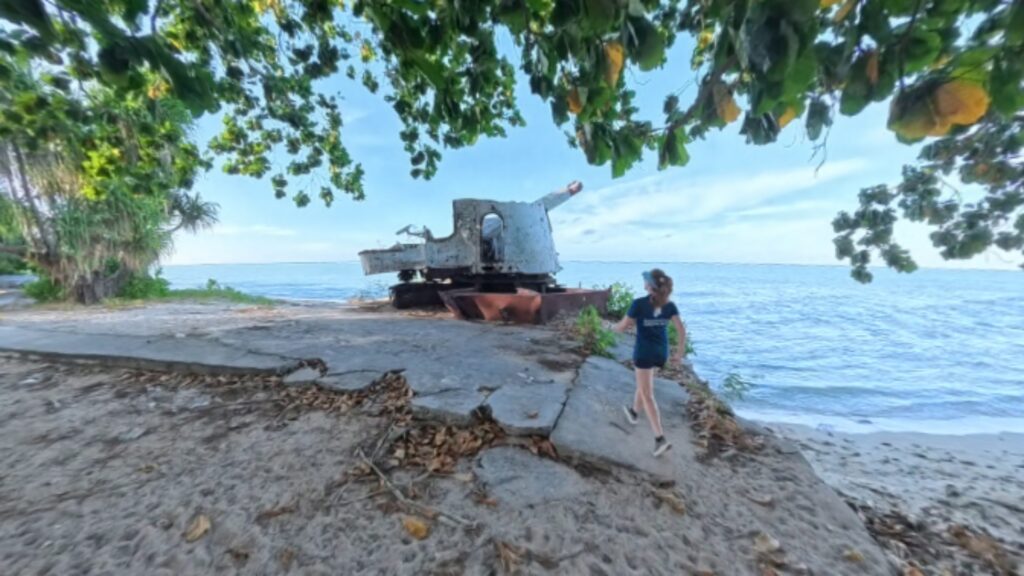
Los marines desembarcaron el 20 de noviembre de 1943. Se enfrentaron a un intenso fuego de estos mismos cañones. Miles de soldados japoneses y trabajadores coreanos defendieron la isla. Más de mil marines murieron en tres días.
Muchos más resultaron heridos. Fue impactante pensar que donde yo estaba había sido un campo de exterminio. La ropa ahora colgaba cerca. Los niños jugaban. La gente vivía en chozas. La basura rodeaba el lugar. La vida había regresado. Aún así, el silencio de la reliquia hablaba con fuerza.

Tomé fotos y pensé en el contraste. Pasar por la historia me pareció surrealista y humilde.
Búnkeres y el Parque Triste
Seguimos corriendo y encontramos búnkeres 💣. Estaban semienterrados. La arena y las plantas los cubrían parcialmente. También estaban rodeados de basura e incluso algunos contenedores marítimos. Estas estructuras habían estado llenas de soldados. Ahora estaban vacías e ignoradas.
Miramos dentro. Estaba oscuro y olía a sal y óxido. Imaginé el miedo y la tensión de los hombres que habían estado allí.
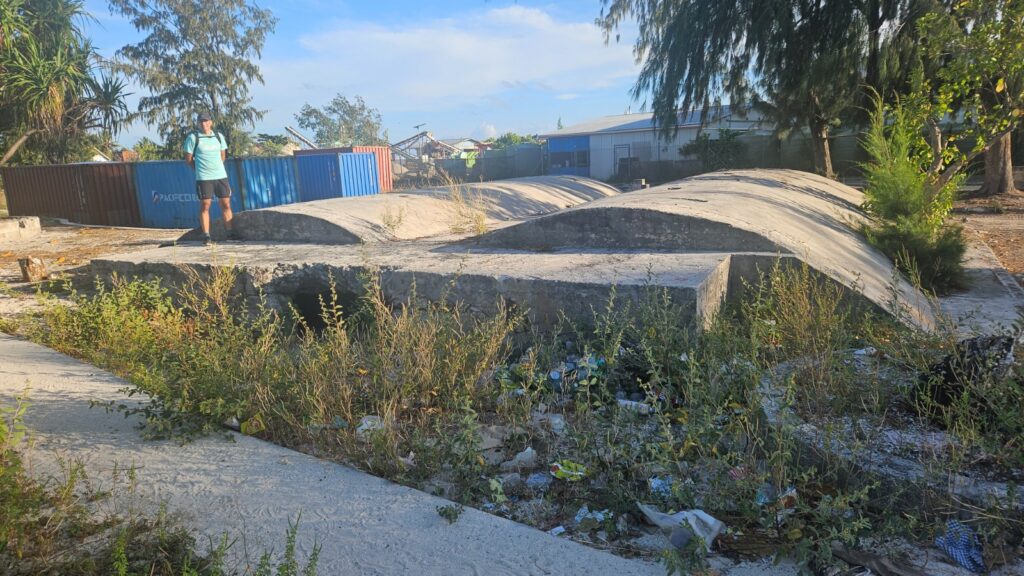
Poco después llegamos al llamado Parque Taiwán 🇨🇳. Lo había construido el gobierno chino para mostrar amistad. Me pareció triste y vacío. Quizás una señal de diplomacia, pero no un espacio animado.
Seguimos adelante y llegamos al inicio de la famosa carretera que conecta Betio con Bairiki. Esta carretera a veces se llama la Calzada Japonesa. Fue construida por ingenieros japoneses durante la guerra para conectar sus fortificaciones.
Tras la batalla, los estadounidenses reconstruyeron partes de él. Hoy es la vía vital de Tarawa Sur. Autos, camiones y autobuses lo cruzan todo el día. Para mí, fue la pista de mi carrera.
Corriendo por la autopista sobre el océano
Corrimos a la autopista 🌊. El peaje estaba vacío. Ayer habíamos pagado allí, pero ahora estaba en silencio.
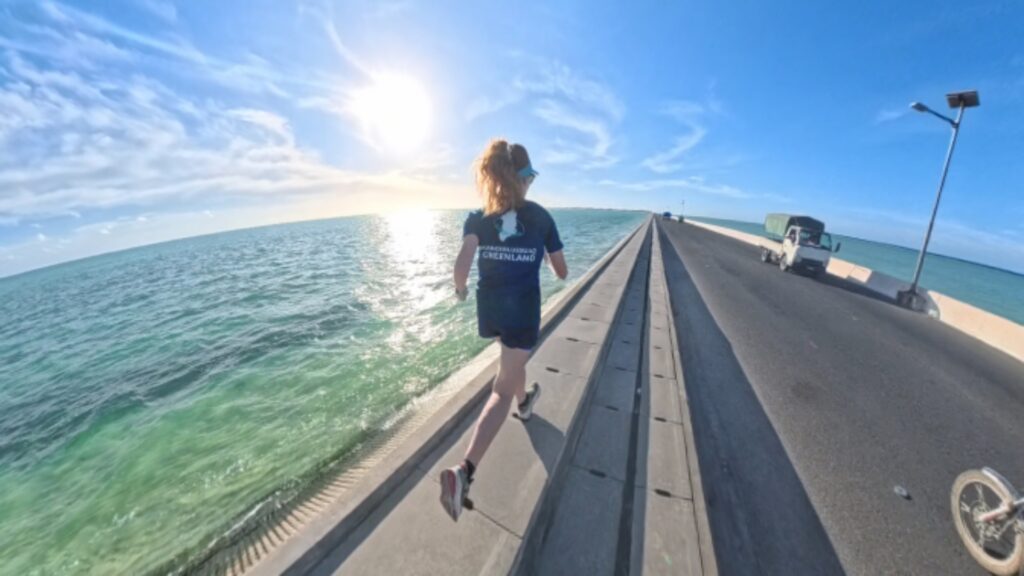
Me subí al muro. No era realmente una acera, pero era lo suficientemente ancha para un corredor. Se sentía firme y plana. Debajo de mí, la marea estaba alta. El agua brillaba, pero había basura flotando en muchos lugares.
Aun así, la vista era hermosa. Por delante se extendían tres kilómetros más bajo un sol que calentaba rápidamente.
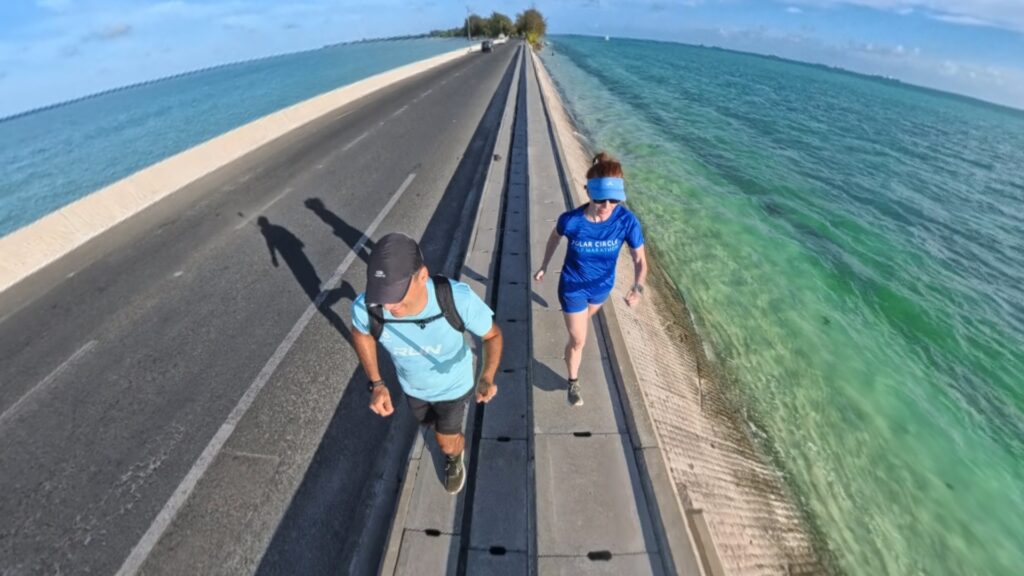
Esta calzada tiene una historia singular. Las fuerzas japonesas construyeron la carretera original durante su ocupación de Tarawa. Esto les permitió trasladar tropas y suministros entre los islotes.
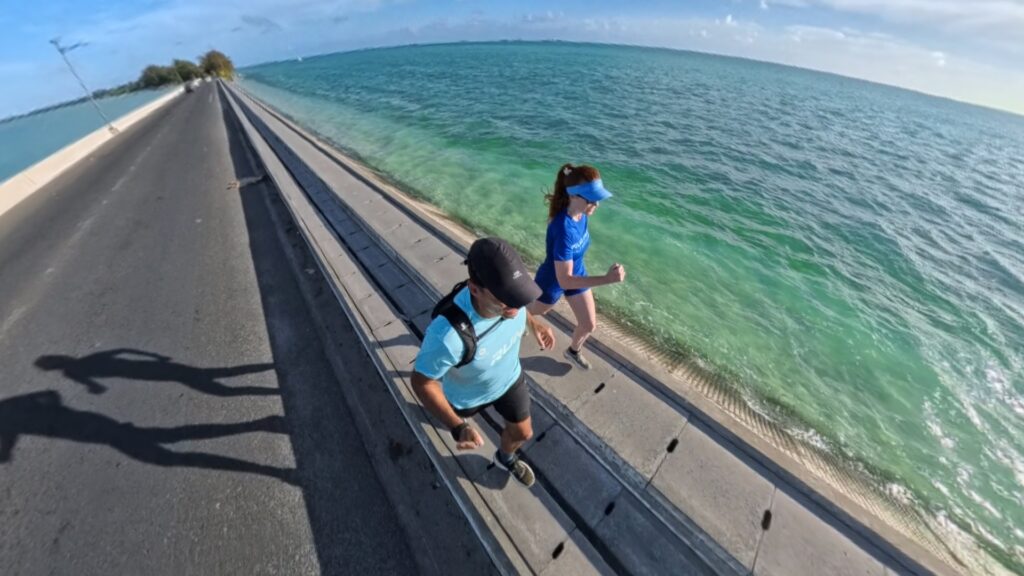
Tras la batalla, los estadounidenses lo ampliaron y repararon. Desde entonces, se ha modernizado. Hoy es vital para la gente de Tarawa. Sin él, Betio estaría aislado de Bairiki y del resto de Tarawa Sur.
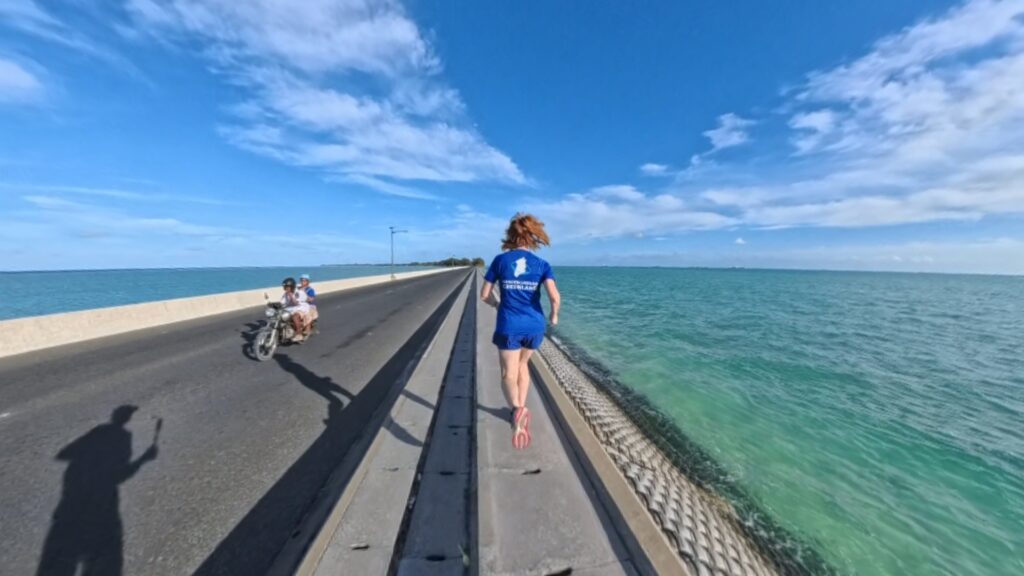
Para mí era más que una carretera. Era un puente sobre el Pacífico donde la historia y la vida cotidiana se mezclan. Correr allí me puso la piel de gallina. Era como correr sobre historias.
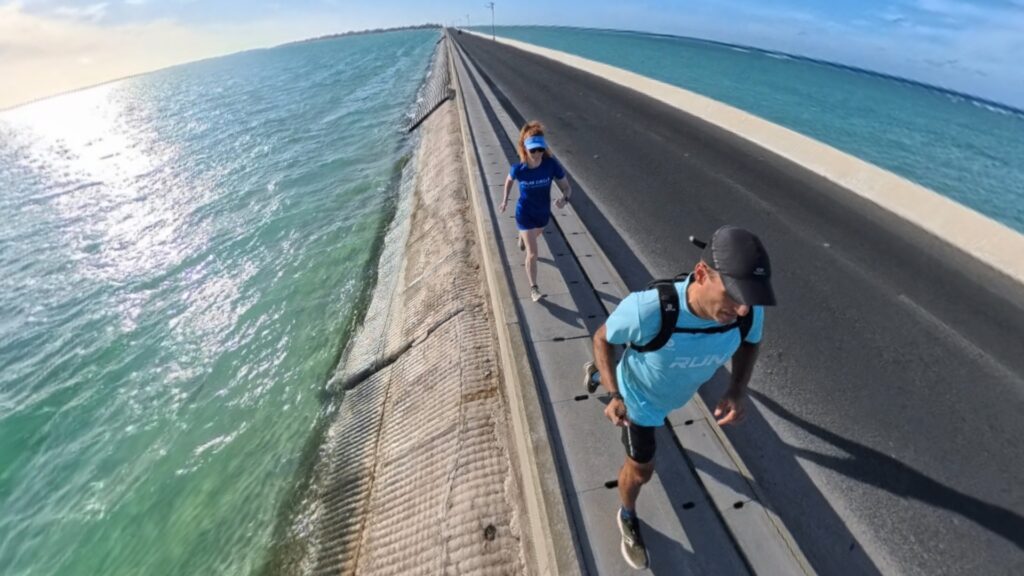
Roger se dio un baño bajando unas escaleras 🚤. Grandes barcos flotaban en el horizonte. Se veía refrescante. Después, regresamos con el viento a favor.
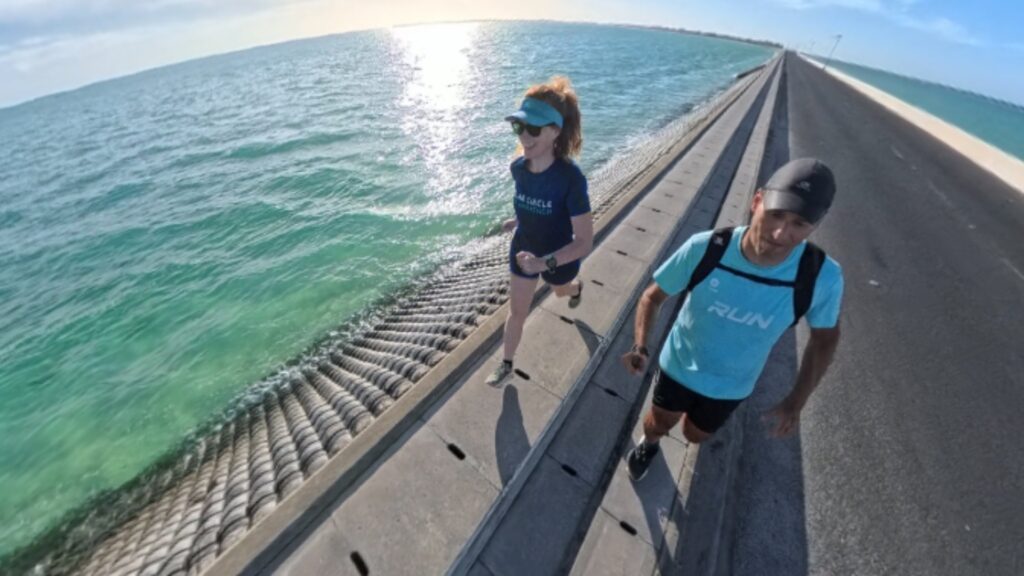
De vuelta a Betio y Reflexiones
Regresamos corriendo con viento de cola 🌬️. Se sintió genial. Pronto vimos a Betio. Ya eran las 8 de la mañana. Niños uniformados caminaban hacia la escuela. Nos miraban con curiosidad. Algunos nos saludaron y nos despidieron con una gran sonrisa. Fue precioso. Al mismo tiempo, el tráfico se hizo más denso. Coches y camiones pasaban cerca. Temí que un perro ladrando me hiciera saltar a la carretera. Por suerte, los perros me ignoraron.
El calor arreció 🌡️. Paramos a la sombra a beber agua. Por fin llegamos al albergue. Mi reloj marcaba más de 8 kilómetros. Me sentía cansado, pero feliz, porque había pasado corriendo junto a cañones y búnkeres japoneses, había cruzado una carretera que antes se construyó para la guerra y ahora sirve a la paz, y había visto crecer la vida alrededor de la muerte.
Correr aquí no era solo ejercicio. También era un viaje a través de la historia en medio del Océano Pacífico 🌴.
🍜 Qué comer antes y después de correr en Kiribati 🏃♀️🥥🐟
Seamos realistas: correr en el calor tropical no es ninguna broma.
Si vas a recorrer las calzadas arenosas y los senderos de polvo de coral de Kiribati, necesitarás combustible. Por suerte, la dieta kiribatiana se basa en ingredientes locales frescos que son tan energizantes como deliciosos. Ya sea que estés cargando carbohidratos antes de correr al amanecer o recuperándote después de un sudoroso sprint por la tarde, aquí te mostramos cómo comer como un campeón (y un local). 😋🏝️
🍠 Carga de carbohidratos antes de la carrera
Si planeas correr por el paraíso, más vale que empieces con los carbohidratos isleños adecuados. Puede que Kiribati no tenga tazones de quinoa ni lattes de avena, pero ofrece comidas energéticas con un auténtico toque tropical. 🌴💪
- 🥥 Babai (Taro gigante de pantano)
Denso, terroso y repleto de carbohidratos de absorción lenta, el babai es la versión isleña de una barrita energética para antes de correr, si esa barrita se cocinara al vapor en hornos subterráneos y se envolviera en hojas de plátano. Es como comer una patata almidonada que se pasó la vida tomando el sol. - 🍌 Plátanos fritos
Dulce, caramelizado y, a veces, peligrosamente adictivo. Piensa en un combustible rico en potasio que sabe a postre, pero funciona como un sobre de gel, solo que con menos químicos y más luz solar. - 🍚 Arroz con crema de coco
Simple pero potente. El arroz blanco bañado en leche de coco cremosa y agridulce le dará a tus piernas lo que necesitan para seguir en movimiento, además de que te hará sentir como si estuvieras cargando carbohidratos. en una hamaca.
🐟 Recuperación de proteínas después de la carrera
Una vez que hayas sobrevivido al calor y la humedad de Kiribati (y, seamos sinceros, solo caminar aquí es una sesión de sudor), necesitarás algo sustancioso para recuperar esos músculos. Por suerte, el océano es tu despensa personal de proteínas. 🌊💪
- 🐠 Pescado de arrecife a la parrilla
Recién capturado y cocinado a fuego vivo. Nada supera un plato de pescado de arrecife aderezado con lima y brisa marina después de la carrera. Además: sin aditivos, aprobado por los corredores 100%. - 🥥 Te bweta (Pollo con ponche de coco)
Este plato combina pollo marinado con savia de coco fermentada para darle un toque dulce y sabroso. Sabe como si tus músculos te chocaran los cinco. (Además, puedes presumir de haber comido néctar de árbol fermentado). - 🥚 Huevos con Pandanus o Fruta del Pan
Si no te apetece mucho pescado, esta versión local de un revuelto para después de correr es perfecta. Repleta de sabores isleños y una guarnición de carbohidratos complejos, es básicamente la respuesta kiribati a un brunch para recuperarse.
CONSEJO PROFESIONAL: ¡Mantente hidratado! 🥥 El agua de coco es la bebida electrolítica natural aquí: sin botellas de plástico, sin azúcares añadidos, solo pura fuerza vital tropical en una nuez.

Información útil
🏃 Rodaje Kiribati, Oceanía.
👟 Mayormente urbano: trae zapatos para asfalto.
✅ ¡La posibilidad de pasar corriendo junto a reliquias de la Segunda Guerra Mundial!
✅ La carretera de Tarawa Sur es realmente un gran lugar para correr (al atardecer o al amanecer, claro).
⚠️ Hace calor y humedad, y es muy difícil llegar. Los vuelos suelen ser bastante caros…

Mapa
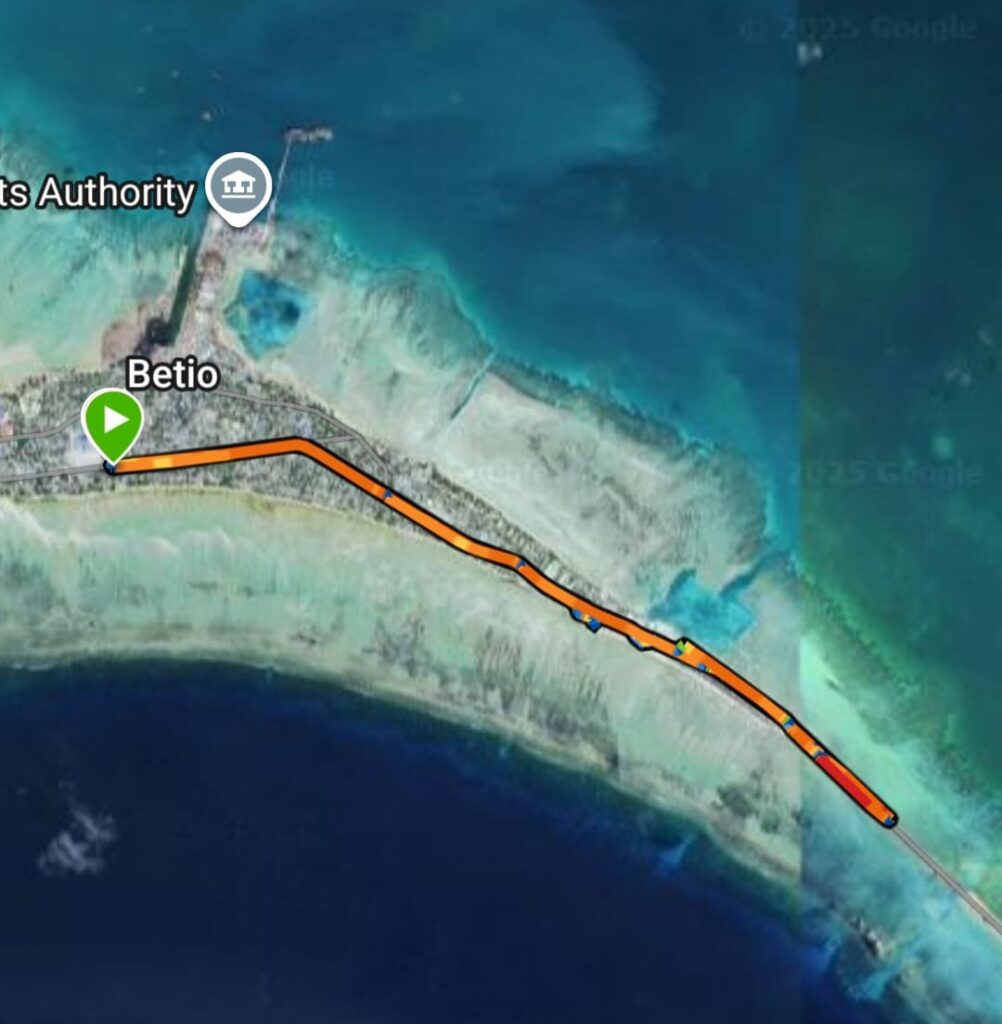

Un libro
📘 “La vida sexual de los caníbales”, de Maarten Troost
Aunque técnicamente es más una memoria de viaje que una novela, La vida sexual de los caníbales Se lee como una aventura narrativa ambientada íntegramente en Kiribati.
Troost y su novia pasan dos años en Tarawa, adaptándose a la vida isleña, las peculiares costumbres y el implacable calor tropical. Capta el humor de la toma de decisiones inducida por el hambre («Estalinismo de coco», su término para la ineficiencia burocrática) junto con conmovedoras observaciones sobre la historia de la Segunda Guerra Mundial, la fragilidad ambiental y la resiliencia de la gente de Kiribati.
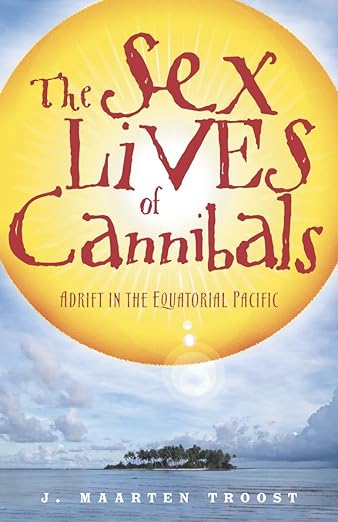
Trama: A los veintiséis años, Maarten Troost, quien había estado apretando el botón de repetición del despertador de la vida acumulando títulos de posgrado inútiles y lidiando con una serie de trabajos temporales, decidió empacar sus chanclas y mudarse a Tarawa, una remota isla del Pacífico Sur en la República de Kiribati. Era inquieto y carecía de rumbo, y la idea de dejarlo todo y mudarse al fin del mundo le resultaba irresistiblemente romántica. Debería haberlo pensado mejor.
La vida sexual de los caníbales cuenta la divertidísima historia de lo que sucede cuando Troost descubre que Tarawa no es la isla paradisíaca que soñó. Cayendo en una divertida desventura tras otra, Troost lucha contra un calor implacable y sofocante, una variedad de bacterias mortales, mares contaminados, peces tóxicos, todo en un país donde la única música que se escucha a kilómetros de distancia es "La Macarena". Él y su fiel novia Sylvia pasan los siguientes dos años luchando contra funcionarios gubernamentales incompetentes, criaturas alarmantemente grandes, electricidad errática y una escasez de opciones de comida (incluida la Gran Crisis de la Cerveza); y lidiando con un extraño elenco de personajes locales, incluido "Half-Dead Fred" y el autoproclamado Poeta Laureado de Tarawa (un borracho británico que nunca ha escrito un poema en su vida).


